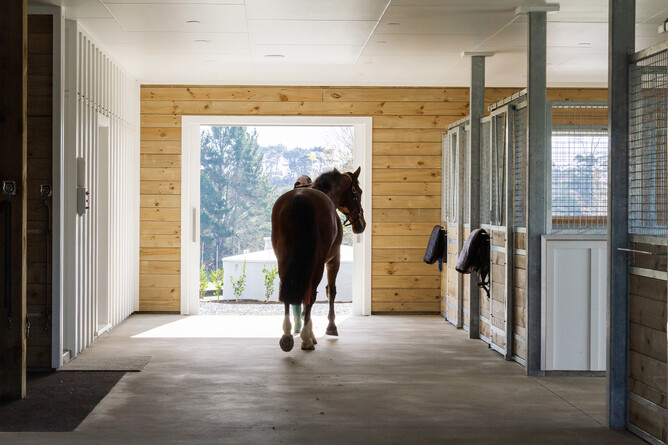Our Top 9.5 Tips for Designing and Building Safer Stables
1. Movement of Horses
Aisles or breezeways between the stables should be at least 3m wide. This will allow horses to pass each other safely when moving around and when being handled or tied up. It will also enable the handler to have plenty of room to work on the horse.
2. Stables, Dividers and Partitions
A loose box for an average sized riding horse should be a minimum of 3.6m x 3.6m; this is a minimum recommendation and if you have the resources to build larger stalls, do. Many people like more generous sized boxes for mare and foals. One of the easiest ways to provide roomy stable accommodation is to be able to take out the partitions between two regular stables. Even if you aren’t planning on breeding this feature of your stables may add value when selling your property.
Stable doors can either be swinging or sliding. In either case there should be latches that undo easily that the horses cannot tamper with. Swinging doors should open out into the breezeway and doors should be at least 1.2m wide.
3. Standing or tie ups
In both tie ups and stables the walls should be solid and sturdy and at least 1.2m high. So, when the horses are tied up, if they pull back, the structure and fittings are strong enough not to break.
4. Ceiling Height
Ceiling height should allow the horse to raise its head comfortably without worrying about hitting the ceiling. A standard room height of 2.4m might be fine for ponies and small horses but bigger horses will need higher ceilings.
5. Lighting
All lighting and wiring should be installed with safety in mind. Wiring should be rodent and moisture proof. Water proof switches throughout the stable are a must. All lighting elements should have safety cages around them and be out of reach of all horses. Try to arrange lighting so there is a minimum of dark or shadow and keep work areas well lit.
6. Windows
Windows provide natural ventilation and lighting. They are also a great feature of the building and can add a lot of character and charm to a stable barn, as well as providing a function. Any windows in an area where horses will be have got to be covered with a grill so that the horse cannot break the glass.
7. Feeding and Watering Equipment
How your horses are going to drink when they are in the stable is a factor that needs to be decided. The most economical way is a bucket on the wall, buckets on the floor need to be secured somehow otherwise when they are knocked over they will create a soiled mess. Automatic waterers mean no carrying of heavy buckets but you will not be able to monitor the amount that your horse is drinking. Some horses are fussy about automatic troughs and don’t like the noise that they make. The troughs need frequent cleaning.
Also think about the positioning and use of hay racks. Remember, it is not natural for horses to eat with their head up instead of down. When planning where these fixtures are going to be position safety should be paramount at all times as so they are not a danger to the horse.
8. Waste Water
Waste water from wash down bays is not supposed to be washed out into the drain. Council regulations are extremely strict on the treatment of waste water and how it is dealt with. Reflections are specialists in the treatment of waste water and how to manage it. Safe disposal of this water will reduce the chance of it carrying disease and cross contamination.
9. Flooring
The most commonly used flooring in stables is concrete. The surface can be roughened in areas where the horses are walking to make the surface non slip. For stables and yards concrete can be put down or they can be left as dirt. Dirt flooring is easier on the horses legs, and may be warmer and quieter than concrete. Dirt floors are harder to clean and may need digging out if the dirt becomes too saturated. Hard floors are easier to clean and disinfect but are harder on the horses legs.
9.5 Careful Project Planning and Consideration
Planning your project carefully and thoughtfully will lead to safer stables and equestrian facilities that are a pleasure to work with.


